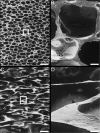Recovery of bacillus spore contaminants from rough surfaces: a challenge to space mission cleanliness control
- PMID: 21216908
- PMCID: PMC3067265
- DOI: 10.1128/AEM.02037-10
Recovery of bacillus spore contaminants from rough surfaces: a challenge to space mission cleanliness control
Abstract
Microbial contaminants on spacecraft can threaten the scientific integrity of space missions due to probable interference with life detection experiments. Therefore, space agencies measure the cultivable spore load ("bioburden") of a spacecraft. A recent study has reported an insufficient recovery of Bacillus atrophaeus spores from Vectran fabric, a typical spacecraft airbag material (A. Probst, R. Facius, R. Wirth, and C. Moissl-Eichinger, Appl. Environ. Microbiol. 76:5148-5158, 2010). Here, 10 different sampling methods were compared for B. atrophaeus spore recovery from this rough textile, revealing significantly different efficiencies (0.5 to 15.4%). The most efficient method, based on the wipe-rinse technique (foam-spatula protocol; 13.2% efficiency), was then compared to the current European Space Agency (ESA) standard wipe assay in sampling four different kinds of spacecraft-related surfaces. Results indicate that the novel protocol out-performed the standard method with an average efficiency of 41.1% compared to 13.9% for the standard method. Additional experiments were performed by sampling Vectran fabric seeded with seven different spore concentrations and five different Bacillus species (B. atrophaeus, B. anthracis Sterne, B. megaterium, B. thuringiensis, and B. safensis). Among these, B. atrophaeus spores were recovered with the highest (13.2%) efficiency and B. anthracis Sterne spores were recovered with the lowest (0.3%) efficiency. Different inoculation methods of seeding spores on test surfaces (spotting and aerosolization) resulted in different spore recovery efficiencies. The results of this study provide a step forward in understanding the spore distribution on and recovery from rough surfaces. The results presented will contribute relevant knowledge to the fields of astrobiology and B. anthracis research.
Figures





References
-
- Anonymous. 2001. Centers for Disease Control and Prevention. Evaluation of Bacillus anthracis contamination inside the Brentwood Mail Processing and Distribution Center B District of Columbia. Morb. Mortal. Wkly. Rep. 50:1129-1133.
-
- Anonymous. 2002. COSPAR planetary protection policy. COSPAR/IAU Workshop on Planetary Protection, October 2002 ed. Committee on Space Research (COSPAR), International Council for Science, Paris, France. (Amended 2005.) http://cosparhq.cnes.fr/Scistr/Pppolicy.htm.
-
- Anonymous. 2008. Microbial examination of flight hardware and cleanrooms. ECSS-Q-ST-70-55C. European Cooperation for Space Standardization, ESA-ESTEC, Noordwijk, Netherlands.
-
- Anonymous. 1999. NASA standard procedures for the microbiological examination of space hardware, NPG 5340.1D. Jet Propulsion Laboratory, National Aeronautics and Space Administration, Pasadena, CA.
-
- Anonymous. 2003. USP 1223: validation of alternative microbiological methods. Pharm. Forum 29:256-264.
Publication types
MeSH terms
LinkOut - more resources
Full Text Sources

